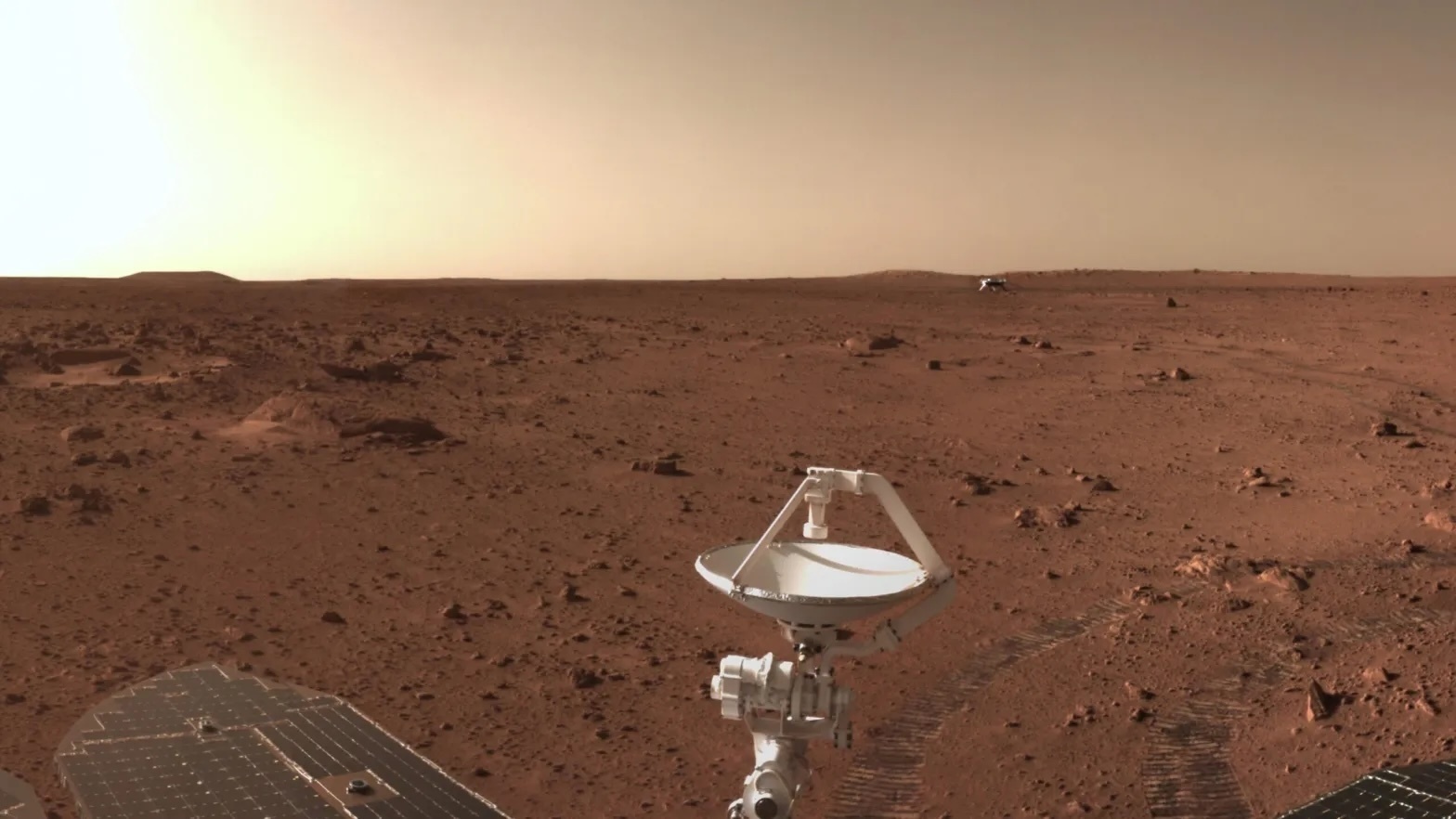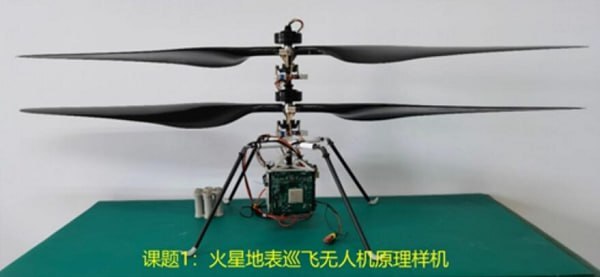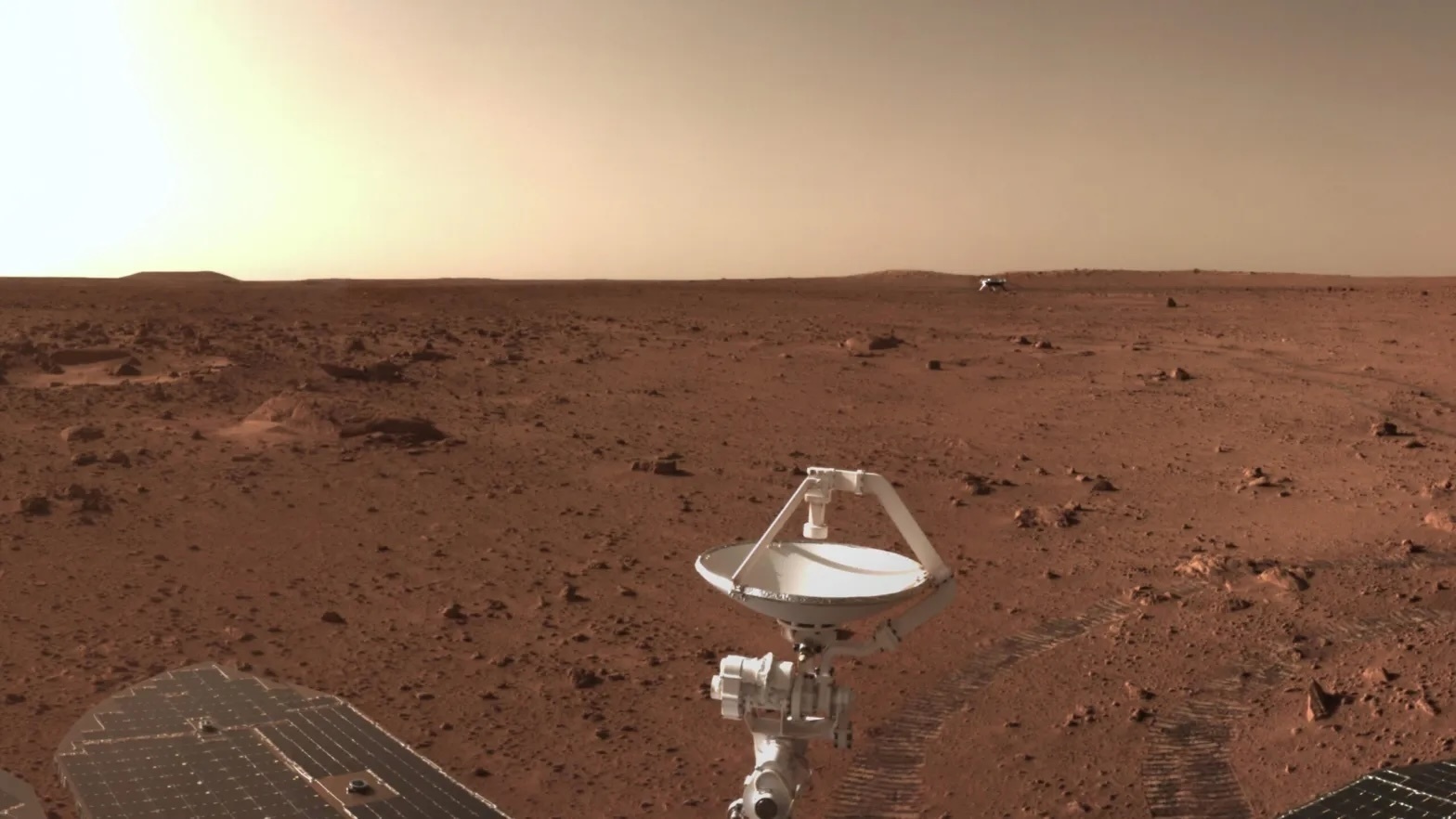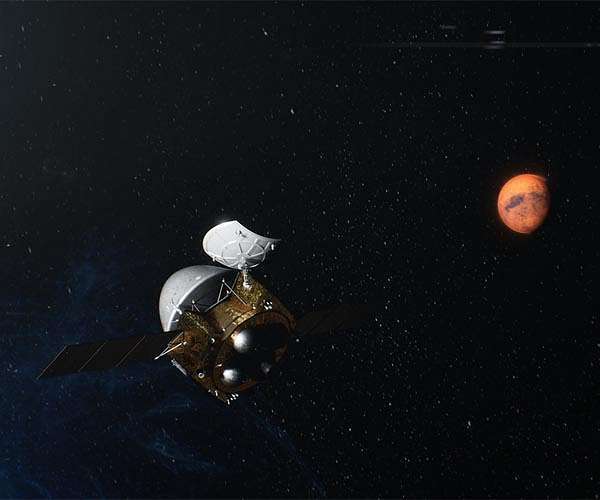14.03.2025
China opens 2028 Tianwen-3 Mars sample return mission to international cooperation

HELSINKI — China is inviting interested parties to submit proposals to join the country’s pioneering Mars sample return mission, due to launch in late 2028.
The China National Space Administration (CNSA) published an announcement of opportunities March 11, officially opening the Tianwen-3 Mars mission to international cooperation.
Tianwen-3 aims to collect samples from Mars and, for the first time ever, deliver them to Earth. The primary scientific goal is the detection of potential biosignatures and answering a fundamental question: has life ever existed on Mars?
“This opportunity is open to the global community. International partners are welcome to collaborate with the TW-3 Mission at the system or payload level,” the CNSA statement reads. The call offers new insights into the mission in terms of mission scheduling and domestic payloads.
Teams can propose piggyback payloads requiring support from the Tianwen-3 spacecraft or independent scientific instruments. CNSA has made up to 15 kilograms of mass available for international collaboration projects on the mission’s Earth return orbiter (ERO) spacecraft and a further 5 kg on the Mars orbiter (MO).
Proposals must align with the mission’s overarching scientific objectives or provide complementary or extended value, with strong innovation in science and engineering.
Expressions of interest are to be submitted to CNSA by June 30, 2025. Shortlisted teams will then be invited to submit full proposals, with final selection scheduled for October. Flight models of selected payloads will need to be delivered in 2027.
The call for collaboration comes as NASA’s own Mars Sample Return program faces delays, cost overruns, and budget uncertainties, raising questions about the future of international Mars sample return efforts, as well as the possibility for wider cuts to the agency’s science and other programs.
Tianwen-3 overview
The Tianwen-3 mission will consist of two separate launches from Earth. Two Long March 5 rocket launches will carry a lander and ascent vehicle and the Mars orbiter and Earth return orbiter respectively.
Launches are scheduled for a once-every-26-months optimal Mars launch window which is due to open for a few weeks spanning late 2028 to early 2029. Samples would be delivered to Earth around 2030 or 2031.
Mars Entry, descent and landing will build on technology used for the Tianwen-1 rover landing. China has already conducted two lunar sample return missions, Chang’e-5 and Chang’e-6, and will launch the Tianwen-2 near-Earth asteroid sample return mission around May this year.
The lander spacecraft aims to collect and launch samples with the help of an ascent vehicle. The Mars orbiter will support communication and science, with the Earth return orbiter tasked with rendezvousing with the ascender in Mars orbit and returning samples to Earth.
Mission objectives are investigating potential traces of life on Mars, studying Martian geology, the planet’s internal structure, and the atmospheric circulation and escape processes, and contributing to understanding planetary habitability.
The spacecraft will carry science payloads to aid these goals, revealed by the CNSA announcement of opportunities.
The lander will carry a Mars Subsurface Penetrating Radar (MSPR) to probe subsurface layers of the Red Planet, and a Raman and Fluorescence Analyzer for Mars (RaFAM) to detect organic materials and minerals, key to astrobiology, similar in function to NASA Perseverance rover’s SHERLOC payload.
The Mars orbiter will carry the Precipitating Energetic Neutral Atom and Aurora Detector (PENAAA) payload to study atmospheric escape processes, and the Mars Orbiter Vector Magnetometer (MOVMag) designed to measure Mars’ magnetic environment.
The ERO will carry the Mid-Infrared Hyperspectral Imager (MIHI) to map Mars’ surface composition, and the Mars Martian Multispectral Camera (MMC) for capturing high-resolution imagery.
The mission may also include a helicopter and a six-legged crawling robot for collecting samples away from the landing site, according to earlier reports, though CNSA has not confirmed these technologies as part of the final mission architecture.
Landing site selection, search for biosignatures
Researchers have identified three preselected landing zones for Tianwen-3. These are Amazonis Planitia, Utopia Planitia—the area within which the Zhurong Tianwen-1 rover landed—and Chryse Planitia.
The mission science group has proposed 86 potential landing sites, according to a 2024 National Science Review paper, focusing on areas that maximize the likelihood of preserving biosignatures, such as locations with ancient deltas, lakes, and water-related landforms, while meeting engineering constraints.
Landing site constraints include an altitude of at least 3 kilometers below the global average to ensure greater atmospheric density for deceleration. Suitable latitudes range from 17° to 30°N, balancing scientific interest with engineering safety factors such as solar illumination, and surface and atmospheric conditions.
Sampling is likely to consist of both surface sampling and drilling. The former will focus on fine-grained sedimentary rocks and clay minerals, which are more likely to contain preserved organics, while the latter approach is designed to reach deeper layers, avoiding the oxidizing effects of Mars’ surface environment.
The mission is highly focused on astrobiology and will also include contamination control and planetary protection measures.
Tianwen-3 could mark a significant breakthrough both scientifically and for China’s space leadership. If successful, Tianwen-3 would establish China as a leader in planetary exploration. The returned samples could be the key to answering one of the most profound scientific questions—whether life ever existed on Mars.
Quelle: SN
----
Update: 24.04.2025
.
China invites int'l partners on Tianwen-3 Mars sample-return mission

The Martian helicopter for the Tianwen-3 mission. Credits: CNSA
The China National Space Administration (CNSA) on Thursday announced opportunities for international cooperation on the Tianwen-3 Mars sample-return mission, inviting global partners to jointly advance Mars exploration and research, thereby expanding humanity's understanding of the red planet.
The Tianwen-3 mission, a significant part of China's planetary exploration program, is scheduled for launch around 2028, according to CNSA.
At a ceremony for Space Day of China held in Shanghai, CNSA announced that the Tianwen-3 spacecraft will allocate 20 kilograms of resources for international collaboration.
The Tianwen-3 spacecraft comprises a lander, an ascent vehicle, a service module, an orbiter and a return module, and it is equipped with six scientific payloads.
The orbiter will operate in a circular Martian orbit at an altitude of about 350 kilometers, and has a designed lifespan of no less than five years. The service module will operate in a highly elliptical orbit, conducting in-orbit exploration for approximately two Martian years with a designed lifespan of no less than five years.
For this mission, the CNSA is offering international cooperation payload resources including no more than 15 kilograms on the orbiter and up to 5 kilograms on the service module. Detailed technical specifications are available on the official CNSA website.
It will take two launches to carry out the Mars sample-return mission due to the limited carrying capacities of the current rockets. Two Long March-5 carrier rockets will be used for the mission, Liu Jizhong, chief designer of China's Mars sample-return mission, said in an earlier interview.
The primary scientific goal of the mission will be to search for signs of life. Other exploration subjects will include the Martian climate and its evolution, Martian geology and the planet's internal processes.
The retrieval of samples from Mars is the most technically challenging space exploration mission since the Apollo program, and no such retrieval has ever been accomplished, Liu said.
Quelle: Xinhua
----
Update: 22.05.2025
.
China invites overseas payload proposals for Mars sample return mission

China is seeking payload proposals for its Mars sample return mission and inviting overseas researchers to participate.
The China National Space Administration (CNSA) has called on overseas research institutions, including those in Hong Kong and Macao, to submit proposals for developing payloads for the Tianwen-3 mission.
The mission, a significant part of China's planetary exploration program, is scheduled for launch around 2028.
The Tianwen-3 spacecraft comprises a lander, an ascent vehicle, a service module, an orbiter and a return module, and it is equipped with six scientific payloads.
The six payloads, namely, the Raman fluorescence spectrometer, ultra-wideband exploration radar, mid-infrared superfine imaging spectrometer, Mars global multicolor camera, descent ENA aurora detector and high-precision vector magnetometer, are all open to overseas researchers, according to a notice released by the CNSA.
The CNSA requires that all payload projects be led by a domestic institution, with no more than five entities involved in the joint development of a single payload.
Last month, the administration announced that it would offer payload resources for international cooperation, with up to 15 kilograms available on the orbiter and 5 kilograms on the service module.
The primary scientific objective of the mission is to search for signs of life on Mars. Other areas of exploration include the Martian climate and its evolution, the planet's geology and its internal processes.
Quelle: Xinhua
----
Update: 24.07.2025
.
Chinese scientist details first planned Mars sample-return mission Tianwen-3
China's first Mars sample-return mission, Tianwen-3, is scheduled for launch around 2028, with the goal of returning no less than 500 grams of Martian samples to Earth by around 2031, according to the mission's chief scientist.
Hou Zengqian, an academician of the Chinese Academy of Sciences and chief scientist of the Tianwen-3 mission, together with his collaborators, recently published an article in Nature Astronomy, systematically outlining the overall plan and scientific objectives of the mission for the first time.
"The mission will be a critical step in China's planetary exploration. We hope to provide the international community with an unprecedented opportunity to understand Mars," Hou said.
The Tianwen-3 mission will involve two launches, and the spacecraft will take seven to eight months to reach Mars. It will operate on Mars for about one year and then return to Earth, with the entire process spanning over three years, according to Hou.
LIFE ON THE RED PLANET?
"We aim to unravel the mystery of whether life ever existed on Mars," Hou said.
He introduced three primary scientific objectives for the Tianwen-3 mission: searching for potential signs of life on Mars, including biomarkers, fossils and archaea; studying the evolution of Mars' habitability, such as changes in water, atmosphere and oceans; and investigating the geological structure and evolutionary history of Mars, from surface features to internal dynamics.
These three objectives are interconnected. The origination of life requires a habitable environment, the proliferation of life evolves in tandem with the environment, and habitability is closely linked to geological processes, Hou explained.
To address these objectives, nine research themes have been established, covering aspects such as life-related elements, environmental conditions and geology, in order to "enhance our understanding of this Earth-like planet in our solar system," Hou said.
HOW WILL SAMPLES BE COLLECTED?
The mission's engineering team has preliminarily designed three sampling methods: surface scooping, deep drilling and drone-assisted collection to ensure sample diversity and scientific value.
Tianwen-3 will not carry a Mars rover. Instead, it will use a drone to collect samples from locations within several hundred meters of the landing site, Hou said.
He noted that Tianwen-3 will be the first mission internationally to conduct 2-meter-deep drilling for sample collection on Mars.
Previously, NASA's Perseverance rover collected shallow surface samples, and will rely on a follow-up mission to return them to Earth. In contrast, Tianwen-3 aims to accomplish both sampling and return in a single mission.
Hou emphasized that planetary protection is a major issue in deep space exploration, and that contamination control is a critical challenge that must be addressed. Strict measures are required to prevent the contamination of Mars by the spacecraft and the potential contamination of Earth's biosphere by Martian samples.
China will adhere strictly to the planetary protection policies of the Committee on Space Research to safeguard Mars from terrestrial contamination and protect Earth from potential Martian life, ensuring authentic and reliable scientific results, Hou said.
The Tianwen-3 mission will establish a complete chain in the sample preservation process, from collection and sealing on Mars to transportation and analysis on Earth. Additionally, a high-security Mars sample laboratory will be constructed, featuring ultra-clean and biosafety areas, where returned samples will undergo strict sterilization, unsealing, processing and biological risk assessment, Hou said.
WHERE WILL SAMPLES BE SOURCED?
"The selection of the landing site on Mars is crucial, as it directly impacts the achievement of the mission's scientific objectives. From an initial pool of over 80 candidate sites, we have narrowed it down to 19, and by the end of 2026, three final candidate sites will be selected," Hou said.
This selection must balance engineering constraints and scientific priorities. Due to engineering limitations, the landing site must be located between 17 degrees and 30 degrees north latitude on Mars. Scientifically, the site should offer the highest potential to harbor and preserve traces of life, the scientist said.
This is akin to mineral exploration on Earth -- it requires the establishment of theories and models to guide predictions, and to then search for a needle in the haystack.
Similarly, identifying a suitable landing site requires a study of the conditions needed for the emergence, proliferation and preservation of life, and the development of predictive models, Hou noted.
If there is or was life on Mars, it would be or have been the result of the interplay of multiple factors, such as liquid water, atmosphere, temperature, magnetic field and internal structure. An ideal landing site should meet the requirements for habitability and life development, Hou said.
OPEN COLLABORATION
China has adopted a fully open and collaborative approach to the Tianwen-3 mission, from the formulation of scientific goals and the development of payloads to the joint research to be conducted on returned samples.
"We aim to build a global platform for scientific collaboration through planetary exploration, advancing humanity's shared scientific endeavors," Hou said.
"During the scientific goal-setting phase, we hosted an international conference, inviting global experts to participate in the discussion. For payloads, China issued an international call for proposals. After the samples are returned, China will open access to international scientists, provided safety is ensured," Hou said.
He added that some key technologies for the Tianwen-3 mission remain under development. The scientific team is leveraging Martian observational data to advance landing-site selection. Meanwhile, to achieve its primary scientific objectives, the team is intensifying full-chain research on the search for life on Mars.
Liu Jizhong, chief designer of the Tianwen-3 mission, said in an earlier interview that the retrieval of samples from Mars is the most technically challenging space exploration mission since the Apollo program, and such a retrieval has never been realized.
To meet this goal, Chinese space engineers have to tackle key tasks such as collecting samples on the Martian surface, taking off from the Red Planet, rendezvousing in the Mars orbit, and protecting the planet from contamination, Liu explained.
The entire process of the mission plan is very complex, involving 13 phases and utilizing in-situ and remote-sensing detection technologies.
Quelle: Xinhua
----
Update: 29.07.2025
.
Chinese scientist details first planned Mars sample-return mission Tianwen 3

China's first Mars sample-return mission, Tianwen 3, is scheduled for launch around 2028, with the goal of returning no less than 500 grams of Martian samples to Earth by around 2031, according to the mission's chief scientist.
Hou Zengqian, an academician of the Chinese Academy of Sciences and chief scientist of the Tianwen 3 mission, together with his collaborators, recently published an article in Nature Astronomy, systematically outlining the overall plan and scientific objectives of the mission for the first time.
"The mission will be a critical step in China's planetary exploration. We hope to provide the international community with an unprecedented opportunity to understand Mars," Hou said.
The Tianwen 3 mission will involve two launches, and the spacecraft will take seven to eight months to reach Mars. It will operate on Mars for about one year and then return to Earth, with the entire process spanning over three years, according to Hou.
Life On The Red Planet?
"We aim to unravel the mystery of whether life ever existed on Mars," Hou said.
He introduced three primary scientific objectives for the Tianwen 3 mission: searching for potential signs of life on Mars, including biomarkers, fossils and archaea; studying the evolution of Mars' habitability, such as changes in water, atmosphere and oceans; and investigating the geological structure and evolutionary history of Mars, from surface features to internal dynamics.
These three objectives are interconnected. The origination of life requires a habitable environment, the proliferation of life evolves in tandem with the environment, and habitability is closely linked to geological processes, Hou explained.
To address these objectives, nine research teams have been established, covering aspects such as life-related elements, environmental conditions and geology, in order to "enhance our understanding of this Earth-like planet in our solar system," Hou said.
How Will Samples Be Collected?
The mission's engineering team has preliminarily designed three sampling methods: surface scooping, deep drilling and drone-assisted collection to ensure sample diversity and scientific value.
Tianwen 3 will not carry a Mars rover. Instead, it will use a drone to collect samples from locations within several hundred meters of the landing site, Hou said.
He noted that Tianwen-3 will be the first mission internationally to conduct 2-meter-deep drilling for sample collection on Mars.
Previously, NASA's Perseverance rover collected shallow surface samples, and will rely on a follow-up mission to return them to Earth. In contrast, Tianwen 3 aims to accomplish both sampling and return in a single mission.
Hou emphasized that planetary protection is a major issue in deep space exploration, and that contamination control is a critical challenge that must be addressed. Strict measures are required to prevent the contamination of Mars by the spacecraft and the potential contamination of Earth's biosphere by Martian samples.
China will adhere strictly to the planetary protection policies of the Committee on Space Research to safeguard Mars from terrestrial contamination and protect Earth from potential Martian life, ensuring authentic and reliable scientific results, Hou said.
The Tianwen 3 mission will establish a complete chain in the sample preservation process, from collection and sealing on Mars to transportation and analysis on Earth. Additionally, a high-security Mars sample laboratory will be constructed, featuring ultra-clean and biosafety areas, where returned samples will undergo strict sterilization, unsealing, processing and biological risk assessment, Hou said.
Where Will Samples Be Sourced?
"The selection of the landing site on Mars is crucial, as it directly impacts the achievement of the mission's scientific objectives. From an initial pool of over 80 candidate sites, we have narrowed it down to 19, and by the end of 2026, three final candidate sites will be selected," Hou said.
This selection must balance engineering constraints and scientific priorities. Due to engineering limitations, the landing site must be located between latitudes of 17 degrees and 30 degrees north on Mars. Scientifically, the site should offer the highest potential to harbor and preserve traces of life, the scientist said.
This is akin to mineral exploration on Earth - it requires the establishment of theories and models to guide predictions, and to then search for a needle in the haystack.
Similarly, identifying a suitable landing site requires a study of the conditions needed for the emergence, proliferation and preservation of life, and the development of predictive models, Hou noted.
If there is or was life on Mars, it would be or have been the result of the interplay of multiple factors, such as liquid water, atmosphere, temperature, magnetic field and internal structure. An ideal landing site should meet the requirements for habitability and life development, Hou said.
Open Collaboration
China has adopted a fully open and collaborative approach to the Tianwen 3 mission, from the formulation of scientific goals and the development of payloads to the joint research it has conducted on returned samples.
"We aim to build a global platform for scientific collaboration through planetary exploration, advancing humanity's shared scientific endeavors," Hou said.
"During the scientific goal-setting phase, we hosted an international conference, inviting global experts to participate in the discussion. For payloads, China issued an international call for proposals. After the samples are returned, China will open access to international scientists, provided safety is ensured," Hou said.
He added that some key technologies for the Tianwen 3 mission remain under development. The scientific team is leveraging Martian observational data to advance landing-site selection. Meanwhile, to achieve its primary scientific objectives, the team is intensifying full-chain research on the search for life on Mars.
Quelle: SD
